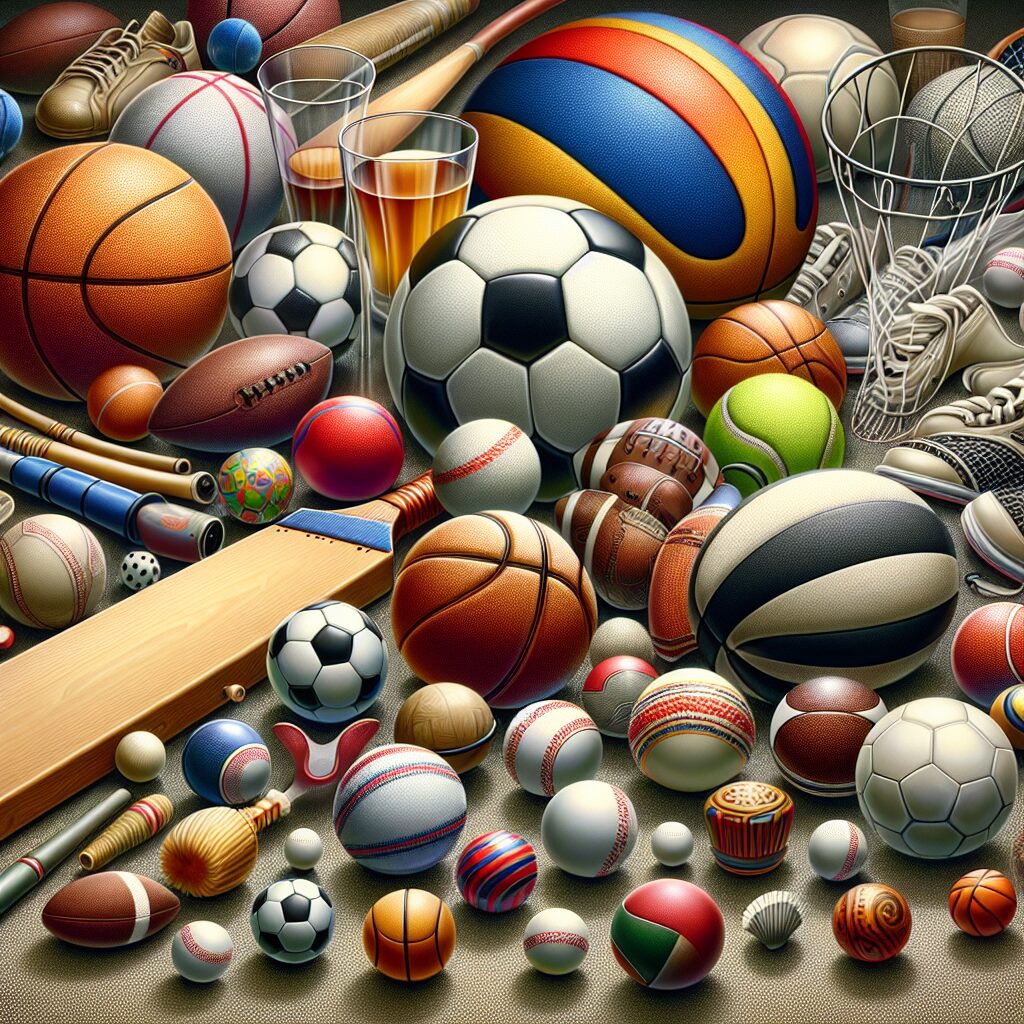Ball games have long been a significant aspect of human culture, serving as cultural signifiers that reveal our identities and pave the way for social bonding. These games, played with various types of balls, encompass a wide range of sports and leisure activities across different societies worldwide. From football to basketball, cricket to baseball, ball games hold immense value in shaping our individual and collective identities, as they embody unique traits and reflect cultural values. For instance, the fast-paced and team-oriented nature of basketball highlights the importance of collaboration and agility, while cricket, with its strategic gameplay, signifies patience and determination. Understanding the cultural significance of ball games can provide valuable insights into our societies and foster a sense of unity among diverse communities.
The impact of ball games on cultural identity is multifaceted and far-reaching. Firstly, these sports act as a source of pride and belonging, allowing individuals to identify with their respective communities or nations. The passion and devotion exhibited by fans during major sporting events create a shared sense of identity, reinforcing cultural values and traditions. Moreover, ball games often serve as vehicles for cultural exchange, bringing people from different backgrounds together and promoting mutual understanding. This interaction fosters a sense of tolerance and appreciation for diverse cultures, breaking down barriers and forming new connections. By examining the cultural signifiers of ball games, we can gain valuable insights into the complex relationship between sports and identity, ultimately fostering a more inclusive society.
Moving forward, this article will delve deeper into the key takeaways of ball games as cultural signifiers, shedding light on their influence on personal and collective identities. We will explore how these sports reflect cultural values, impact social cohesion, and promote a sense of community. Additionally, we will analyze the role of ball games in shaping gender and national identities, as well as their potential to bridge cultural divides. By understanding the intricate ties between ball games and identity, we can celebrate the rich diversity within our societies, not only on the playing field but also in our everyday lives.
Key Takeaways
1. Ball games have long served as cultural signifiers, reflecting and shaping a community’s identity and values.
2. The nature of ball games greatly impacts their cultural significance, with team sports often fostering communal spirit and unity, while individual sports may signify personal achievement and independence.
3. The historical background and development of ball games provide valuable insights into societal changes and power dynamics.
4. Ball games can act as powerful tools for social integration, offering opportunities for individuals from diverse backgrounds to come together and bond over a shared passion.
5. The transmission of ball games through generations strengthens cultural heritage and fosters a sense of belonging within a community.
What is the Role of Ball Games in Establishing Cultural Identity?
The History of Ball Games
Ball games have been played by various cultures throughout history, serving as not only a form of entertainment but also a way to establish cultural identity. From ancient civilizations to modern societies, ball games have held significant cultural value, often reflecting the values, traditions, and beliefs of a particular group.
Physicality and Skill
Ball games require physicality and skill, making them a prime platform for showcasing cultural identity. Different cultures have developed unique playing styles, rules, and techniques, highlighting their distinct physical attributes and abilities. Whether it is the athleticism of basketball, the finesse of soccer, or the precision of cricket, ball games provide individuals and communities with a means to express their cultural prowess and competitive spirit.
Symbolism and Rituals
Beyond the physical aspect, ball games often carry deep symbolism and rituals that contribute to cultural identity. These symbolic elements can include pre-game ceremonies, chants, dances, and the use of specific equipment or attire. For example, the Maori Haka performed by New Zealand’s rugby team not only displays their passion for the sport but also serves as a cultural symbol representing strength, unity, and intimidation.
Social Cohesion and Identity
Ball games serve as a powerful tool for fostering social cohesion and reinforcing cultural identity within a community. They bring people together, create a sense of belonging, and promote positive social interactions. Whether it is local leagues or international competitions, ball games provide a shared experience that strengthens cultural ties, instills pride, and builds a sense of identity among participants and spectators alike.
Promotion of Cultural Values
Through ball games, cultural values can be promoted and preserved. The inherent values within each game, such as teamwork, fair play, respect, and perseverance, align with the core principles of many societies. As individuals engage in ball games, they not only learn these values but also reinforce and pass them down to future generations, ensuring the continuity of cultural identity.
Economic and Tourism Impact
Ball games have a significant economic and tourism impact on societies. Major sporting events attract visitors from around the world, leading to increased tourism revenue, job opportunities, and infrastructure development. Moreover, the promotion and commercialization of ball games contribute to economic growth, generating income through ticket sales, sponsorship deals, merchandising, and media rights.
How Can Ball Games Strengthen Cultural Identity?
1. Encourage grassroots participation: By promoting ball games at the grassroots level, organizations can create opportunities for individuals from diverse backgrounds to engage with and embrace their cultural heritage through sports.
2. Preserve traditional playing styles: Efforts should be made to preserve and promote traditional playing styles of ball games, ensuring that cultural nuances are maintained and celebrated.
3. Encourage inclusivity and diversity: Ball games should be seen as platforms that embrace inclusivity and diversity, allowing individuals from various ethnic, racial, and cultural backgrounds to participate and contribute to the development of their cultural identity.
4. Support cultural education: Schools and educational institutions play a vital role in educating students about the cultural significance of ball games, instilling a sense of pride and appreciation for their cultural heritage.
5. Promote cultural exchange: Encourage international tournaments, friendly matches, and collaboration between different countries to foster cultural exchange and mutual understanding through ball games.
6. Utilize modern media platforms: Leverage the power of modern media platforms to showcase and promote diverse cultural identities associated with ball games, creating awareness and appreciation on a global scale.
7. Foster partnerships with cultural institutions: Collaborate with cultural institutions, museums, and heritage organizations to showcase the historical and cultural significance of ball games, providing a deeper understanding of their impact on cultural identity.
8. Engage with local communities: Organize community events, workshops, and exhibitions that involve local communities in the celebration of ball games, fostering a sense of ownership and pride in their cultural heritage.
By embracing the power of ball games as cultural signifiers, societies can strengthen their cultural identities, promote inclusivity, and celebrate the diverse richness of human civilization.
Frequently Asked Questions
What are ball games?
Ball games are sports that involve the use of a ball as the primary object of play. These can include sports such as soccer, basketball, baseball, volleyball, and tennis, among others.
How do ball games relate to identity?
Ball games can serve as cultural signifiers that reflect and shape individual and collective identities. They often carry historical, social, and cultural significance, becoming an integral part of a community’s identity.
Why are ball games considered cultural signifiers?
Ball games play a significant role in shaping and expressing cultural identities due to their popularity and widespread participation. They have become deeply embedded in various cultures, representing values, traditions, and shared experiences.
Can ball games be used to explore cultural diversity?
Absolutely! Ball games provide an excellent lens to explore cultural diversity. Different countries, regions, and communities develop unique playing styles, rules, and rituals, reflecting their distinct cultural backgrounds and identities.
How have ball games influenced popular culture?
Ball games have had a profound impact on popular culture, influencing various aspects such as music, fashion, film, and advertising. Iconic athletes and memorable sporting moments have become revered symbols of cultural significance and have inspired countless creative works.
Do ball games contribute to societal bonding?
Yes, ball games often foster a sense of unity and community, enabling people from diverse backgrounds to come together and share a common interest. They serve as a platform for social interactions, creating shared experiences and connections among individuals.
Can ball games be seen as a form of cultural expression?
Indeed, ball games can be considered a form of cultural expression. They showcase not only physical prowess and skill but also embody cultural values, narratives, and histories. Through these games, cultures can express themselves and demonstrate their uniqueness.
Are ball games only played competitively?
No, ball games can be played both competitively and recreationally. While professional leagues and tournaments attract significant attention, many people engage in ball games as a form of leisure and recreational activity, enjoying the physical and social aspects of the sport.
Do ball games reinforce gender stereotypes?
Unfortunately, ball games have historically perpetuated gender stereotypes, with certain sports being more associated with specific genders. However, efforts are being made to promote inclusivity and break down these stereotypes, encouraging participation and equal opportunities for all.
How can ball games contribute to personal identity formation?
Ball games provide individuals with opportunities for self-expression, personal growth, and the development of skills and values. Engaging in ball games can help shape one’s self-identity and allow individuals to connect with their passions, communities, and cultural heritage.
Final Thoughts
Ball games have transcended mere physical activities and have become profound cultural signifiers that shape our identities. From the World Cup to the Olympics, these sports hold immense symbolic value, uniting people from all walks of life under a common passion. They reflect the values, traditions, and histories of communities, becoming part of their cultural fabric. Furthermore, ball games have the power to transcend borders, providing a vehicle for cross-cultural understanding and appreciation. By celebrating the diversity of playing styles, rituals, and narratives, we can embrace the rich tapestry of identities that ball games contribute to.
As we analyze the impact of ball games on identity formation, it is crucial to recognize the ongoing efforts towards inclusivity and equality within these sports. Breaking down gender stereotypes and providing equal opportunities for all individuals, regardless of their background, is essential for creating a truly inclusive ball game culture. By reinforcing values of respect, fairness, and diversity, ball games can continue to evolve as powerful cultural expressions that unite us and contribute to the richness of our collective identities.




